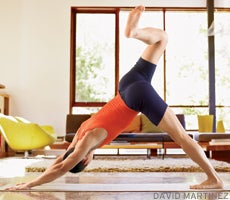Heading out the door? Read this article on the new Outside+ app available now on iOS devices for members! Download the app.
Q: What’s the best way to do Chakrasana? I’d like to try it, but feel daunted by it. Are there any steps to ease my way into it?
—Denise Richards, New York, NY
Tim Miller’s reply:

Chakrasana (Backward Somersault) presents both a physical and psychological challenge to many. Chakra means “wheel,”
which correlates to both the rolling action of the somersault and the circular shape of the spine as you perform the
pose. One way to create this roundness and begin practicing the pose is to use a blanket, much as you would in Salamba
Sarvangasana (Supported Shoulderstand).
Place the blanket under your shoulders so the neck and head extend beyond it onto your mat. Once you have your blanket
set up, bring the legs overhead into Halasana (Plow Pose). To get more roundness in the spine, bend the knees and bring
them toward the ears. Place the hands on the mat underneath the shoulders and bring the elbows over the wrists. Resist
the tendency for the elbows to splay apart in Chakrasana—this only weakens the work of the hands and arms and puts
more pressure on the neck, and your hands are the primary source of leverage here to roll the body over.
Keep the chin pressed firmly against the top of the chest and gaze at the navel to protect the neck. Press the back of
the head against the floor and push into your hands to roll yourself over. It’s a good idea to use a soft surface
(carpet or grass) when learning this pose.
A critical element when performing the pose is learning how to use the breath effectively. Since Chakrasana is
traditionally used at the end of a vinyasa sequence, you should already have a steady breathing pattern established.
To try the pose without props, start by lying on your back. As you inhale, lift the legs until they are parallel to the
floor, then exhale as you push through the hands and roll over. The toes should point in the direction you want to
travel—in this case the junction of the wall and the floor behind you. Push through both hands equally, and do not
turn your head to see where you are going or you risk injuring your neck.
The last crucial part of Chakrasana is learning to turn the wheel from the center. As you exhale and roll, firmly
contract the lower belly and pelvic floor to make the spine round (in flexion). This helps drive your body over itself,
just like driving a wheel from the hub. Keep the muscles of the pelvis floor and lower abdomen engaged during
Chakrasana to ensure that there is strength in the center of the wheel.
Tim Miller has been a student of Ashtanga Yoga for over twenty years and was the first American certified to teach by Pattabhi Jois at the Ashtanga Yoga Research Institute in Mysore, India. Tim has a thorough knowledge of this ancient system, which he imparts in a dynamic, yet compassionate and playful manner. For information about his workshops and retreats in the United States and abroad visit his Web site, www.ashtangayogacenter.com.